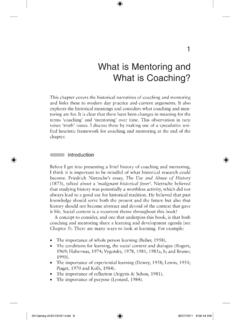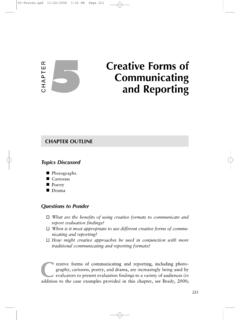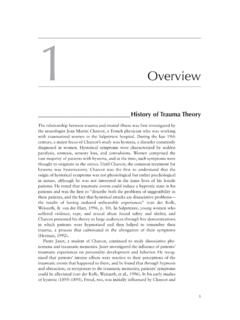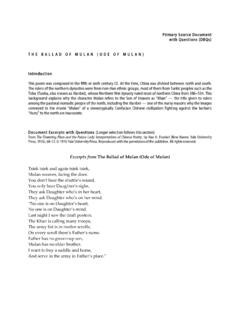Transcription of THE CONCEPT OF CULTURE - SAGE Publications Inc
1 9 This treatise on the study of cross-cultural differences between mod-ern societies starts with an examination of the various ways in which CULTURE has been conceptualized. Approaches to the CONCEPT and study of CULTURE have varied between academic disciplines, and some-times even within them. The goal of this analysis is not to provide one right perspective. CULTURE can be whatever a scholar decides it should be. What we need is not a single best theoretical definition of CULTURE but clear empirical operationalizations of each approach: Researchers need to explain exactly how they propose to measure CULTURE in accordance with their conceptualizations, diverse as they may be.
2 1 THE CONCEPT OF CULTURE 10 Understanding CULTURE The Unpackaging of CULTURE Psychologists who compare individu-als from different nationalities or ethnic groups often observe differences between them on the dependent variables that they study. In such cases, they may show that various psychological variables, as well as age, gender, educational level, and more, produce a statistical effect that seems to account for the differences. But what if some of the variance remains unexplained?
3 In that case, it was common practice until recently to refer to an obscure residual called CULTURE . Originally, the CONCEPT of CULTURE seemed even more opaque to researchers who compared organizations in different countries. In the words of Child (1981), In effect, national differences found in characteristics of organizations or their members have been ascribed to .. national differences, period (p. 304). To a cultural anthropologist, CULTURE is neither obscure, nor a residual.
4 It is a social phenomenon that manifests itself quite clearly, even if the manifestations are not always easy to explain. Anthropologists consider CULTURE an important phenom-enon that warrants its own field of study. They do not view it as a single variable; being an extremely complex system, it is to be analyzed in terms of its components and their relationships. Although cross-cultural psychologists and organizational behavior experts accepted this logic rela-tively late, by now they too have grasped the need to unpackage CULTURE rather than approach it as a monolithic block.
5 1 This chapter and the next prepare the reader for the third one, which represents an unpackaging exercise. We must start with a philosophical warning at the very outset of our journey. We will not try to find out what is in the package because that would be futile. CULTURE is not a specific material object that has its own objec-tive existence. It is underpinned by real phenomena that, however, we perceive and analyze subjectively.
6 Therefore, the best that we can do in a discussion of the nature of CULTURE is to explore the subjec-tive conceptualizations of various schol-ars. Then, we can discuss the contents of the package labeled CULTURE as they have been seen by cross-cultural experts. Meaning of the Word CULTURE and Definitions of the CONCEPT The origin of the Latin word cultura is clear. It is a derivative of the verb colo (infinitive colere), meaning to tend, to cultivate, and to till, among other things (Tucker, 1931).
7 It can take objects such as ager, hence agricultura, whose literal meaning is field tilling. Another possible object of the verb colo is animus ( character ). In that case, the expres-sion would refer to the cultivation of the human character. Consequently, the Latin noun cultura can be associated with edu-cation and refinement. The etymological analysis of CULTURE is quite uncontroversial. But in the field of anthropology, the situation is much more complex.
8 Definitions of CULTURE abound and range from very complex to very simple. For example, a complex definition was proposed by Kroeber and Parsons (1958): transmit-ted and created content and patterns of values, ideas, and other symbolic- meaningful systems as factors in the shaping of human behavior (p. 583). An even less easily comprehensible definition was provided by White (1959/2007): By CULTURE we mean an extrasomatic, temporal continuum of things and events dependent upon symbol-ing (p.)
9 3). Often cited is also a definition by Kluckhohn (1951): CULTURE consists in patterned ways of thinking, feeling and reacting, acquired and transmitted mainly by symbols, constituting the distinctive achievements of human groups, including their The CONCEPT of CULTURE 11 embodiments in artifacts; the essential core of CULTURE consists of traditional ( historically derived and selected) ideas and especially their attached val-ues. (p. 86, no. 5) But that is not all.
10 Geertz (1973) noted sarcastically that in some twenty-seven pages of his chapter on the CONCEPT , Kluckhohn managed to define CULTURE in turn as .. [what follows is 11 differ-ent definitions]; and turning, perhaps in desperation, to similes, as a map, as a sieve, and as a matrix (p. 5). This lack of clarity and consensus about anthro-pologists main object of study may be one of the reasons that, in the words of Cochran and Harpending (2009), the social sciences and especially anthropology haven t exactly covered themselves in glory (p.)

















